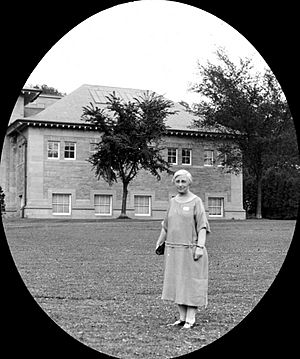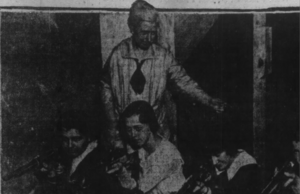Sophia Eckerson facts for kids
Quick facts for kids
Sophia Eckerson
|
|
|---|---|

Dr. Eckerson at the International Congress of Plant Sciences in Ithaca, New York (August 1926)
|
|
| Born | c. 1880 |
| Died | July 19, 1954 |
| Citizenship | United States of America |
| Alma mater | Smith College |
| Scientific career | |
| Fields | Botany Microchemistry |
| Institutions | Boyce Thompson Institute University of Wisconsin Washington State University University of Chicago |
| Thesis | A Physiological and Chemical Study of After-Ripening (1911) |
Sophia Hennion Eckerson (born around 1880 – died July 19, 1954) was an American scientist. She was a botanist, which means she studied plants. She was also a microchemist, focusing on tiny chemical changes. Sophia was famous for tracking how chemicals change inside plants as they grow and develop.
Contents
Sophia Eckerson's Life
Sophia Eckerson was born around 1880 in Old Tappan, New Jersey. Her exact birth date is not known. After finishing high school, she did not go to college right away. Instead, she helped her brothers with their college studies.
Her College Years
By 1901, Sophia enrolled at Smith College in Massachusetts. There, a professor named William Francis Ganong inspired her. She decided to study botany (the study of plants) and plant physiology (how plants work).
Sophia earned her first degree in 1905. She stayed at Smith College to get her master's degree, which she finished in 1907. During these years, she also taught botany and plant microchemistry. She worked as an assistant in the botany department.
In 1909, Sophia went to the University of Chicago. She earned her Ph.D. degree in 1911.
Her Career in Science
After getting her Ph.D., Sophia Eckerson became an assistant plant physiologist at the University of Chicago. She worked there until 1915. Then, she became an instructor in plant microchemistry.
During this time, she also worked as a microchemist for Washington State College. In 1919, she joined the U.S. Department of Agriculture. She also worked with the University of Wisconsin from 1921 to 1923.
Sophia taught and did research at the University of Wisconsin. In 1924, she took a job at the Boyce Thompson Institute for Plant Research in Yonkers, New York. This was a big step in her career. She stayed there for the rest of her working life. She even became the head of the institute's Microchemistry Department.
Sophia was also a leader in the Botanical Society of America. She was vice-chair in 1934 and chair in 1935 of the physiology section. This was a rare achievement for a woman at that time. She received special awards for her research and service to science in 1941 and 1951.
Because her work often required her to move around the country, Sophia Eckerson never married. She stopped working in 1940. She passed away on July 19, 1954, in Pleasant Valley, Connecticut, after a short illness.
Sophia Eckerson's Research
Sophia Eckerson's research focused on the amazing chemical changes that happen inside plants.
Seed Development
Her Ph.D. work looked at how plant embryos change when seeds start to grow. She studied different types of hawthorn seeds. She found that certain chemicals and activities increased as the seeds prepared to sprout.
Wheat Plant Growth
At Washington State College, she studied how wheat plants grow. She tracked the chemical and physical changes in wheat throughout its life. She paid close attention to the chemical changes as the grain ripened.
While at the University of Wisconsin, she made an interesting discovery. She found tiny structures inside the cells of wheat plants. These structures were linked to a plant sickness called rosette disease. Her team found that a fungus in the soil caused this disease. Sophia used her microchemistry skills to study the affected plant tissues. She documented these tiny structures, which were not present in healthy wheat plants.
Tomato and Other Plants
Later, at the Boyce Thompson Institute, she continued studying plant diseases. She looked at how leaves of mosaic-infected tomato plants changed.
In 1931, her work shifted to detailed chemical tests. She studied how not having enough phosphorus affected tomatoes. She also looked at how certain chemicals were spread in apple trees. And she researched how plants use nitrates from the soil.
Toward the end of her career, she studied how plants make proteins from the soil. She also researched how plants like cotton create cellulose particles. Cellulose is what makes up plant cell walls. She retired in 1940, leaving behind a legacy of important discoveries about plant chemistry.


